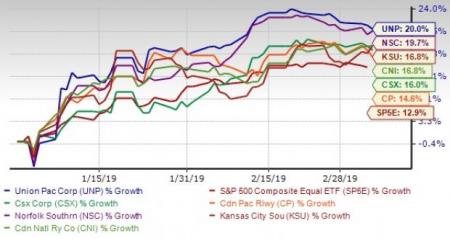On Mar 6, CEOs of two major freight railroads — Lance Fritz of Union Pacific Corp. (NYSE:UNP) and Jim Foote of CSX Corp. (NASDAQ:CSX) told CNBC that the U.S. economy still holds lot of potential for freight railroads. Both the CEOs unanimously agreed that “the U.S. industrial still looks pretty healthy” buoyed by a robust labor market, record low unemployment level and solid wage growth. They further added “overall wealth for consumers looks pretty good”.
The railroad industry seems to be poised well not only in the near term but also in the long haul on the back of robust freight demand fueled by a buoyant U.S. economy. A strong U.S. economy supports the bullishness of freight railroad operators, as it implies that more goods are being transported across the country. Currently, nearly 35% of the U.S. exports are shifted to the ports by freight railways.
Strong Intermodal Business
Growth of intermodal volumes in recent years is anticipated to drive railroads’ top line. Volumes at this key revenue generating unit rose 5.6% in 2018, thanks to an increasing number of freight conversions from highway to rail due to limited truck supply.
Intermodal segment has improved significantly in 2019. In the last two weeks of February, intermodal volumes grew a significant 816,986 units. Strong intermodal volumes have been bolstering railroads’ top line and the uptrend is likely to continue going forward. Improving prospects of intermodal segment has been benefiting railroads since the beginning of the year. Further, the railroad operators’ sustained cost-reduction efforts are anticipated to drive the bottom line going forward.
Although coal volumes have historically contributed the maximum to rail carloads, the companies have shifted their dependence to intermodal on account of dwindling coal volumes. Notably, intermodal now reportedly dominates overall carloads. Apart from a low truck count, growing e-commerce demand is another catalyst behind growth of intermodal. Consequently, the sluggish coal scenario is likely to be less of a hindrance for railroads.
Robust AAR Data
The Association of American Railroads (“AAR”), the industry body of the class 1 freight railroad operators, reported that U.S. rail traffic (including carloads and intermodal units) was pegged at 528,153 for the week ended Mar 2, 2019. This reflects an increase of 1.1% from the previous week. Two of the 10 carload commodity groups reported an increase compared with the same week in 2018. Total U.S. rail traffic for the first eight weeks of 2019 was 4,120,979 carloads, up 0.1% year over year.
Additionally, railroads have been witnessing an improvement pertaining to another key metric -- operating ratio (operating expenses as a percentage of revenues) in 2019. The lesser the value of operating ratio, the better, as it implies that more cash is available to the company to reward shareholders through hike in dividends or share buybacks.
Performance of Major Railroads
Year to date, stock price of six major railroad operators, Union Pacific, Canadian Pacific Railway Ltd. (NYSE:CP) , CSX Corp., Norfolk Southern Corp. (NYSE:NSC) , Canadian National Railway Co. (NYSE:CNI) and Kansas City Southern (NYSE:KSU) outperformed the benchmark S&P 500. Union Pacific carries a Zacks Rank #2 (Buy). You can see the complete list of today’s Zacks #1 Rank (Strong Buy) stocks here.
Is Your Investment Advisor Fumbling Your Financial Future?
See how you can more effectively safeguard your retirement with a new Special Report, “4 Warning Signs Your Investment Advisor Might Be Sabotaging Your Financial Future.”
Click to get it free >>
Norfolk Southern Corporation (NSC): Free Stock Analysis Report
Kansas City Southern (KSU): Free Stock Analysis Report
CSX Corporation (CSX): Free Stock Analysis Report
Canadian Pacific Railway Limited (CP): Free Stock Analysis Report
Canadian National Railway Company (CNI): Free Stock Analysis Report
Union Pacific Corporation (UNP): Free Stock Analysis Report
Original post
Zacks Investment Research
